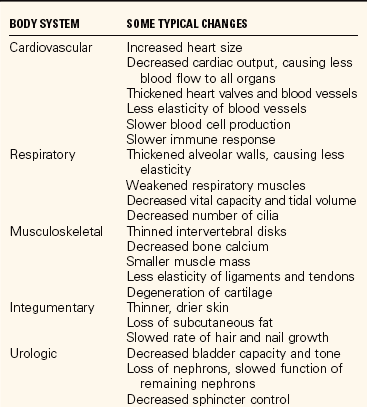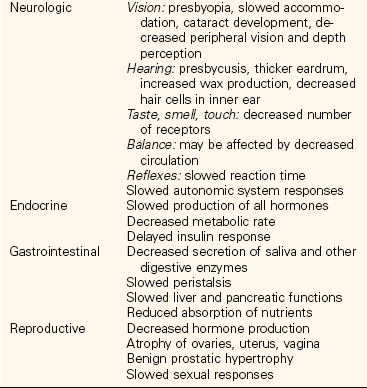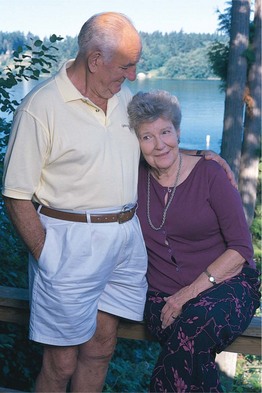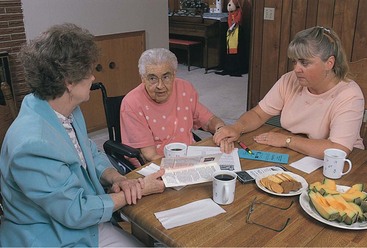Promoting Healthy Adaptation to Aging
Upon completing this chapter, you should be able to:
1 Compare the biologic theories of aging.
2 State how a person might behave in response to the psychosocial theories of aging.
3 Identify four factors that contribute to longevity.
4 Discuss physical changes that occur as adults get older.
5 Explain Schaie’s theory of cognitive development in the older adult.
6 Explain Erikson’s stage of psychosocial development in the older adult.
1 Identify at least six signs and symptoms of normal aging.
2 Design an educational program to help older adults maintain physical health.
3 State three ways the nurse could help older adults maintain cognitive health.
4 Identify nursing problems related to changes in psychosocial health.
5 Guide the older adult’s family members regarding signs that the older person needs assistance.
ageism ( , p. 173)
, p. 173)
aging (p. 168)
benign senescence ( , p. 170)
, p. 170)
biologic theories (p. 171)
centenarians ( , p. 170)
, p. 170)
dementia ( , p. 171)
, p. 171)
demographic ( , p. 170)
, p. 170)
ego integrity (p. 174)
elder abuse (p. 174)
gerontologists ( , p. 168)
, p. 168)
life span (p. 169)
longevity ( , p. 169)
, p. 169)
psychosocial theories ( , p. 169)
, p. 169)
reminiscence ( , p. 174)
, p. 174)
wisdom (p. 172)
OVERVIEW OF AGING
Aging (a continual process of biologic, cognitive, and psychosocial change) begins at conception. Although there is no way to escape it, we can learn to live with it. As a nurse, you will care for people of all ages. In most health care settings, many of your patients will be older adults. You are also aging, as are family members and friends. Knowing about normal development in the later years of life will help you in many ways.
Older adults are not all alike. Some are active, busy, and healthy; others are inactive because of illness and may be dependent on others. Being an older adult means different things to different people; it is your perception of aging that influences your definition of being old.
Because Americans are living longer than they did a few generations ago, scientists are interested in learning how a healthy body can be achieved into advanced years. Research about healthy aging is ongoing, and results are changing our ideas. Many older adults have the ability and potential for years of interesting and productive living. For them, the later years of life are exciting and rewarding. Most people do not mind growing older, especially if they are relatively healthy. Some, however, fear that the later years of life will be painful, boring, and filled with illness and despondency. Box 13-1 contains the Healthy People 2010 major goals and objectives for older adults. Overcoming the myths about aging (Box 13-2) can be a challenge for nurses when working with middle and older adults.
THEORIES OF AGING
There are numerous theories about aging. Some gerontologists (specialists in the study of aging people) claim that aging is primarily determined by genetics, whereas others are just as certain that environment and lifestyle play important roles. It is obvious thatthose factors interact, along with other things, to determine how long a person lives.
Biologic theories (theories based on cellular function and body physiology, or apoptosis) provide ways to look at the physical aging process. The biologic clock is one of these theories; this states that body cells are programmed to function for a specific length of time, after which they break down and die. When too many cells quit functioning, the person eventually dies.
Advocates of the free-radical theory believe that cells are damaged by toxins, ions break off from ion pairs, and the resulting free radicals are unstable. This occurs in the environment, in waste products of metabolism, and from disease. These toxins are causes of free radicals, or oxidizing substances in the body; the use of antioxidant vitamins and lotions is supposed to counteract the harmful chemicals. The wear-and-tear theory states that body cells and organs eventually wear out, like machinery.
In the immune system failure theory, the system loses its ability to protect the body from disease. Older persons become more susceptible to diseases such as influenza, which may kill them. The autoimmune theory is similar; here the body no longer recognizes itself, and begins to attack itself and break down, as occurs in some types of arthritis.
There are also psychosocial theories (theories related to socialization and life satisfaction). The disengagement theory, since rejected, suggests that it is normal for older people and society to withdraw from each other. Most gerontologists no longer give credence to this concept.
The activity theory states that people who remain interested and active will continue to enjoy life and to live longer. Conversely, people who make no effort to contribute become less and less involved and shorten their life as a result.
In the continuity theory, each individual continues to live and develop as the unique person he or she is. Individuals’ basic personalities do not change, and they will cope with aging in ways similar to the ways in which they coped with other stages of life.
LONGEVITY
The life span (the maximum years a species is capable of living) for human beings is 115 to 130 years. Longevity (length of life) has been increasing. In 1900, the average length of life in the United States was 47 years. In 2004, the U.S. Bureau of the Census projected the average life span to be 77.9 years. What caused this increase?
A major contributor to longer life is that people are healthier throughout their lives now than they were 100 years ago. Principles of hygiene have helped eliminate many illnesses. Health care has improved, anti-infective drugs are in common use, and technology allows surgeons to perform intricate procedures and replace more body parts. Improved nutrition is also another factor in longer life.
Education also contributes to longevity. People who are better educated seem to be more aware of how their bodies work and make more efforts at staying healthy. These people practice preventive health care and may seek treatment earlier in the course of an illness.
Lifestyle makes a significant difference in longevity. A healthy diet and regular exercise are crucial. Nonsmokers usually live longer than smokers; people who abuse chemicals risk shortening their lives. People who are married tend to live longer. Stress management is part of a healthy lifestyle, too.
A person’s personality seems to affect the length of life as well as its quality. The optimistic, happy person generally lives longer. This is true even when a chronic illness is present.
Gender has been a contributing factor to longevity in the past; women in the 20th century lived 6 to 7 years longer than men. Currently, if a man reaches age 75, he dies only 2 years sooner than the average woman. The final factor in longevity is genetics. Gerontologists had claimed that heredity determined 50% of longevity, but recent research lowers that to about 30%.
DEMOGRAPHICS
Demographic (statistics about populations) studies show that there are more older people in the United States every year. In 2000, there were nearly 35 million people over 65, only 12.4% of the total population. U.S. Bureau of the Census experts predict that by 2030, nearly 66 million people, or 25.6% of the population, will be over 65.
For purposes of study, the older adult or elderly population is often divided into three distinct groups: the “young old” are 65 to 74 years of age, the “middle old” are 75 to 84, and the “very old” are 85 and beyond. Sixty-five years is used because the federal Social Security system uses the 65th year as a marker for retirement. As people live longer, the government may change that marker to 67 or even 70.
The young old are those who remain fairly healthy and active. You may not even recognize them as old when you see them in the shopping mall, restaurant, or theater. Many continue to contribute to their community and may remain employed, at least part time. They are not much different from middle adults.
The middle old are in a transition time. As people approach 80, they often become more frail and are thus less able to be as active. The very old are the most rapidly growing group, and this group will continue to increase in the future. These are also the most dependent older adults.
Centenarians (people 100 years old or older) are becoming more common. About 72,000 people were 100 years old in 2000. It is projected that there will be 129,000 centenarians by 2010, and the U.S. Bureau of the Census projects that by 2050, that figure will rise to 834,000 (U.S. Bureau of the Census, 2004).
Living a long and better life is everyone’s goal. The ancient Greeks are credited with being the first to say they wanted to “die young, as late in life as possible.” Most people who have become centenarians have been in good health at least into their 90s. To live to be very old, you have to be healthy for most of your life. People are becoming healthier, better educated, and actively involved in their own health care, and are therefore living longer.
PHYSICAL CHANGES
Physical declines happen to everyone. Benign senescence (normal physical changes of aging) begins occurring early in adulthood, but often goes unnoticed until a problem develops. Changes mentioned in Chapter 12 continue. Table 13-1 summarizes the physiologic changes that occur with aging. Heart and lungs gradually become less efficient. Bones become more fragile and posture becomes bent.
The skin is thinner and more fragile; a reduced amount of subcutaneous tissue causes older adults to complain of feeling cold. Older people often have smaller appetites. Vision continues to deteriorate; night driving becomes difficult.
Hearing deficits may become more pronounced. Nearly 75% of the population over age 75 has some hearing loss. Various types of hearing aids can be very helpful. The earlier a person with hearing difficulty obtains a hearing aid, the better the brain can adjust to it and provide a good quality of hearing.
Changes in the brain also occur with normal aging. There may be less blood flow. Chemicals vital for nerve functions may be imbalanced. Because brain cells do not easily regenerate, losses caused by injury or illness will affect the body’s functions. The brain can adapt by growing more dendrites up to age 90 if the person is reasonably healthy. Brain changes are also important in trying to understand cognitive changes in older adults, such as sensory and memory losses.
HEALTH CONCERNS
Most people over 75 have at least one chronic health problem. Hypertension is the most common; 51% of older adults have hypertension. Arthritis is second, with 48% of older adults have some joint stiffness. Heart disease is third, with 31% of older adults having some cardiac problem. Obesity contributes to joint problems by causing increased stress on joints; it also contributes to hypertension. For many older adults, these conditions do not seem to prevent living active and full lives.
Other common concerns include anemia, diabetes, influenza, cancer, malnutrition, cirrhosis, and mental illness. The leading causes of death are heart disease, cancer, stroke, lung disease, accidents, diabetes, and Alzheimer’s disease (National Center for Health Statistics, 2004).
Older people are often concerned about falling, especially about breaking a hip, and about being dependent on others (Health Promotion Points 13-1). Accidents may happen because of changes in depth perception, changes in gait, and slower reaction times. It is important to teach older people safety measures to prevent falls (see Chapter 40).
Mental health in the older adult may be difficult to evaluate. Many physical conditions, such as malnutrition, dehydration, infection, and misuse of medications, can lead to impaired cognition. A thorough examination should be done to make an accurate diagnosis. About 6% of older adults are clinically depressed, whereas 37% have depressive symptoms (National Institute of Mental Health, 2007). Depression can often be treated successfully with medications and counseling.
Dementia (degeneration of brain tissue) occurs in a small percentage of older adults. The incidence rises as aging progresses. Confusion, memory loss, and disordered thinking are early signs. There are numerous causes of this problem, from malnutrition to mini-strokes to Alzheimer’s disease. (Alzheimer’s disease is covered in Chapter 41.) Table 13-2 compares the memory decline that is age-related with depression-related and dementia-related memory problems. Between 6% and 10% of older adults have dementia; two thirds of that number have Alzheimer’s disease.
Table 13-2
Memory Decline as the Result of Normal Aging, Depression, or Dementia
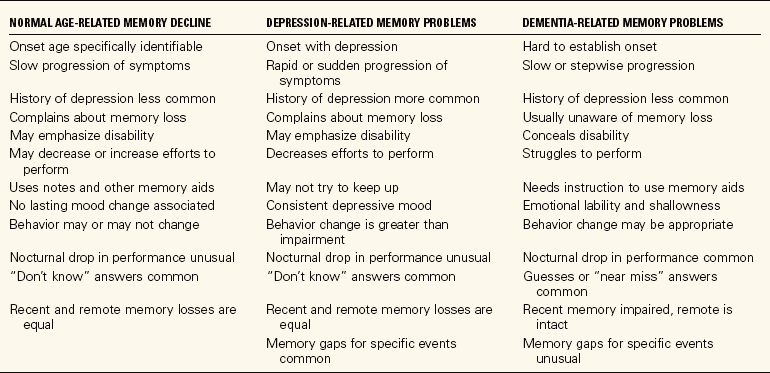
From Leifer-Hartson, G., & Hartson, H. (2004). Growth and Development Across the Lifespan: A Health Promotion Focus, Philadelphia: Saunders.
HEALTH PROMOTION BEHAVIORS
One behavior that helps delay physical aging is eating a healthy diet. Older adults should be encouraged to learn about nutrition and meal planning. Additional seasonings can counter the loss of taste buds. Some physicians encourage a daily multivitamin. Eating is a social experience for many, so they should find opportunities to share meals with others. Many communities offer communal dining; prepared meals can also be delivered to a home.
Physical activity also postpones many effects of aging. Many older adults participate in regular exercise groups. Daily activity, whether walking, biking, or swimming, keeps the body functioning. Older adults also benefit from weight training. The Exercise Guide for Older People, in English or Spanish, is available free from the National Institute on Aging. It describes appropriate exercises to keep fit and promote good balance.
Another positive behavior is having regular physical examinations to monitor chronic conditions and to screen for new problems. Older adults may need encouragement to participate in their own health care management. The cost of health care is a concern to some, but there are programs designed for older adults that will help provide regular care.
Older adults who smoke should be encouraged to quit. They may have been smoking for years, but the health benefits of quitting are significant, even in advanced years. The use of nicotine patches and a support group may be helpful. Alcohol use should also belimited as its effects may be greater in the elderly and it may interfere with prescribed medications. Some adults may need guidance in taking prescribed medications correctly (Health Promotion Points 13-2).
COGNITIVE ASPECTS OF AGING
Schaie’s stage of cognitive development for older adults is called the reintegrative stage. This states that older adults are more selective about how they will spend their time. They will take time for interesting things, but not for things that seem irrelevant. A woman who regularly hosts family meals on special occasions may try new recipes and enjoy a cooking class. However, someone who lives alone and rarely entertains may not be interested in such activities.
Discovering the interests of older persons can provide clues to ways to stimulate and maintain their cognitive abilities. One person may enjoy crossword puzzles and another may enjoy reading mysteries.
Healthy adults can maintain intelligence into advanced years. The speed of thinking may slow, but thinking processes remain intact. Many older adults who are ill or who have vision or hearing deficits do not suffer cognitive dysfunction. They should be certain that glasses and/or hearing aids are in place before interacting with other persons.
WISDOM AND LEARNING
Wisdom (having good judgment based on accumulated knowledge) is often credited to older adults because of their wealth of life experiences. Younger people can benefit by listening to the advice of older people.
Because older adults sometimes think more slowly, some people assume they can no longer learn. This is not true. Subjects of interest can fascinate the older learner (Patient Teaching 13-1). They have more patience for learning. Many have learned to operate computers and enjoy using that technology. Elder hostel programs, often operated by colleges, provide stimulating opportunities to learn and sometimes travel with other older adults.
MEMORY ISSUES
Some older adults have problems remembering recent events; this is short-term memory loss. They may not recall much of yesterday. However, long-term memory remains intact. They can remember many details of their younger life. Memory aids such as making lists or notes on a calendar can help keep life orderly (Health Promotion Points 13-3).
The more severe memory losses and dementias of aging are often the result of circulatory changes. Persons experiencing memory changes and their family members should not assume that such changes are inevitable. The older adult should be evaluated for nutritional status, hypertension, arterial health, an endocrine disorder, and specific neurologic problems. Sometimes underlying conditions can be treated and the memory problems will also be resolved.
EMPLOYMENT AND RETIREMENT
The ability and desire to keep a job is an individual decision, depending partially on the cognitive ability of the older adult. Some types of work maintain a mandatory retirement age, particularly if the work involves public safety. In other situations, retirement is a matter of preference.
Some people are eager to leave a regular job and may retire in their 50s or early 60s. Some continue to work because they need the income. Retiring early requires planning for finances and other concerns. Other people enjoy working and want to continue beyond a traditional retirement age. According to the U.S. Bureau of Census statistics, about 10% of older adults have incomes that place them in the poor or near-poor category (Senior Journal, 2005). About 5 million older adults are employed at least part time.
Workers who lose their jobs a few years before retirement may find it hard to obtain other employment at similar wages. Ageism (discrimination because of age) is illegal in the United States. A worker who has lost a job in favor of a younger person has recourse through the government and the courts.
Retirement brings with it major changes in many aspects of lifestyle: no alarm clock, no set schedule, no coffee break with co-workers, no need to dress neatly, no paycheck. People who have adequate finances may feel comfortable about retiring. Some will travel extensively if health and finances permit.
Many early retirees discover they have time on their hands and begin a second career. Older adults may continue to work in family businesses. Others volunteer to keep themselves busy and involved. The contributions of older adults should not be underestimated. About 7% of grandparents are providing extensive care for grandchildren; 1 out of 15 of those are putting in enough hours for it to qualify as a full-time job (Senior Journal Editors, 2007). Again, attitude is important. People whose lives revolved around their work may have difficulty adjusting to retirement. Sometimes people without other interests become disillusioned with retirement and find another job. Other people become depressed, withdraw, feel useless, and die. Recent retirees should be encouraged to set small daily or weekly goals until the adjustment has been made.
HEALTH PROMOTION BEHAVIORS
Behaviors that help with successful cognitive aging are the same behaviors that are encouraged throughout life. Having a positive attitude remains important. Some people are unhappy with their lives and unwilling to try to change; it is not easy for health care workers to accept that. Encouragement is always appropriate. For example, you can remind them of their past accomplishments, of their success in raising children, or even the accomplishment of living a long life.
Active involvement in a job and community during earlier adulthood often carries into continuing involvement in hobbies, religious and service groups, and volunteerism in older adulthood. Older adults can be reminded of how much they have to offer their community because of their broad experience.
Using the brain by reading, doing puzzles, using a computer, and writing keeps the neural connections active and healthy. A computer game called “Brain Age” has been shown to improve cognition in the elderly. The brain is like a muscle in one way: it should be exercised regularly. Even the older adult who is physically limited can maintain mental stimulation with a little effort.
PSYCHOSOCIAL ASPECTS OF AGING
Erikson’s stage of development for older adults is called ego integrity (state of being complete) versus despair (see Table 11-2). Older persons naturally spend time thinking about their lives. If they find their lives have been good, then they are satisfied and have ego integrity. However, if they are unhappy about the way life has evolved, they will despair. Resolution to ego integrity may occur if you can help the person find enough areas of satisfaction to outnumber the areas of regret.
LIFE REVIEW
This is the time for reminiscence (reviewing one’s life). If individuals accept that they have had good lives, and that they have contributed to others, then they are satisfied. People who were not successful at working through a developmental stage when younger may find unhappiness with the way their lives progressed. Sometimes it is enough to realize that one did the best one could under the circumstances.
Many psychologists consider this stage of life review important as a person faces mortality. Being content with past accomplishments is important for self-worth at any stage of life. The older adult simply has more years about which to reflect.
FAMILY RELATIONSHIPS
Families continue to be important in older adulthood. Married people seem to live longer than those who are alone (Figure 13-1). Widows usually adjust better than do widowers. According to the U.S. Bureau of the Census (2002), 43% of all women over 65 are widows; 14% of men are widowers (Administration on Aging, 2005). Many widowed, divorced, or single older adults may continue to date, and some will remarry.
The majority of older adults who have children live within 40 miles of one child. Contact with that child usually occurs at least weekly. One reason this is important is that the older parent may need assistance with one or more aspects of daily life.
The active older adult may contribute to extended family life by helping with child care of grandchildren or great-grandchildren. Sometimes retired adults end up raising grandchildren. Adult children may have died or may be imprisoned, hospitalized, or otherwise unable to care for the children. This arrangement can bring both benefits and problems for the children and for the older adults.
Nearly 2.1 million older adults are affected by elder abuse (any type of abuse of the elderly). Those over age 80 have the greatest incidence, with the primary type being neglect. This is a 15.6% increase since 2004 (National Center on Elder Abuse, 2006). When it occurs in a family, it is for many of the same reasons abuse happens to children or spouses. Elder abuse may occur in a long-term care setting (Legal & Ethical Considerations 13-1).
SOCIAL ACTIVITY
Community involvement was discussed earlier relative to cognitive development; it is also important for psychosocial health. Older adults need to feel needed; this contributes to their self-concept and emotional health. Some volunteers and part-time workers choose those activities primarily for the social activity.
Older adults experience a gradual loss of their peer group as friends and siblings die. These can be difficult times for the survivors; they continue to need support from their family and community. Those who have cultivated friendships with younger people fare best.
LIVING ARRANGEMENTS
Many older adults prefer to live in their own homes as long as they are physically able. Others choose to rent an apartment when they cannot maintain a house and yard. About half of older adults (54.7%) lived with a spouse in 2004 (Administration on Aging, 2005). About 30.8% live alone; many of these need some assistance at times. About 671,000 grandparents age 65 or over maintained households in which grandchildren were present in 2004. That number continues to grow.
According to the U.S. Bureau of the Census, only 4.5% of all people over age 65 lived in long-term care settings and 5% lived in senior housing in 2000 (U.S. Bureau of the Census, 2000). This percentage increases with age, with nearly 18.2% of people over age 85 residing in long-term care settings.
As more people live to be older adults, it is important for them to remain healthier longer. This is beginning to happen. People over 85 remain the most frail and will probably continue to need help with daily activities. As that group grows, more nurses and other health care workers will be needed to give care.
HEALTH PROMOTION BEHAVIORS
Older adults have several psychosocial challenges to face. They need to accept and adjust to a changing body. Family roles change, especially if one spouse becomes ill or dependent on the other, or dies. There are changes in the use of time as a result of retirement. Finally, older adults have to face their own mortality.
The helpful behaviors for these adjustments continue to revolve around maintaining an optimistic outlook, staying as physically fit as possible, and remaining involved with others. Those who face the future with a hopeful, positive attitude will cope better with aging.
Older adults should be encouraged to make a living will and to designate someone to make health care decisions for them in case they cannot. Completing a durable power of attorney for financial arrangements is recommended. Each state has guidelines and forms that can be obtained from lawyers or health clinics. The office of the patient’s physician should be given a copy of the documents.
Older adults with children should involve them in planning. If there are no children, another relative, a younger friend, or a trusted lawyer can be named as their trustee.
WHEN A PARENT NEEDS HELP
It is not easy for adult children to admit that a parent needs their assistance. Sometimes the nurse can help stimulate a conversation about the future and offer resources for the family.
Some older adults recognize that they will need help and will initiate discussion with their children or others (Figure 13-2). They may decide when to move to a smaller apartment or into an assisted living arrangement. Others will deny their aging and resist making any changes until a crisis arises. This denial is an understandable way of maintaining their dignity and self-esteem.
PLANNING AHEAD
Experts suggest that adult children keep communication lines open with their parents. The parent may need encouragement to discuss alternative living arrangements or other changes that may be needed. Adult children should try to do the following:
• Plan ahead: Discuss possibilities and make plans with the parent before a crisis occurs. This way decisions will be mutually agreeable and less traumatic.
• Include everyone: Siblings should share in planning and decisions. No one adult child should be made to feel wholly responsible.
• Find important information: This includes knowing about the parent’s financial situation, the medical care presently received, medications used, and alternative housing possibilities. If parents are reluctant to discuss changes, it sometimes helps to allow more time for them to think about it. Consider the choices and seek resources.
OBSERVING CHANGES
Safety is a basic need. Adult children will have to make decisions for parents who are no longer able to safely care for themselves. If older adults show signs of deteriorating behavior, it is time for adult children to make some of those decisions for them (Box 13-3).
RESOURCES FOR FAMILIES
Many communities provide services for older adults, including adult day services, chore services, transportation, counseling, companionship programs, exercise and rehabilitation programs, and telephone reassurance services. To learn what is available in your community, begin with the yellow pages in the phone book. Your state agency on aging coordinates information. The federal Administration on Aging and the Internet can also provide information. AARP (the American Association of Retired Persons) can provide information about services for older adults.
Some websites for information are www.aoa.gov, www.aarp.org, www.cdc.gov/aging, and www.caregiver911.com.
NCLEX-PN® EXAMINATION–STYLE REVIEW QUESTIONS
Choose the best answer(s) for each question.
1. Demographers in the United States predict that there will continue to be more older people because: (Select all that apply.)
1. the baby boomers are healthier as they get older than were previous generations.
2. medical technology is extending life for many, especially those with heart disease.
3. most people today are much happier than were those of previous generations.
4. there are more wealthy people who can afford good health care.
5. more vitamins and supplements are available to delay aging.
2. The biologic clock theory of aging states that:
1. body systems eventually wear out.
2. body cells are destined to live a specific period of time.
3. The majority of older Americans live in:
4. To fulfill Erikson’s psychosocial stage, older adults can be encouraged to:
1. play with their grandchildren.
2. continue with hobbies and light exercise.
5. The important behaviors that can help an older adult to age successfully include:
6. In order to help parents plan for possible future changes, adult children should:
1. investigate alternative housing arrangements.
2. keep communication lines open within the family.
7. The U.S. government defines old age as the time when full Social Security benefits become available, which is after age
8. Signs of elder abuse include: (Select all that apply.)
9. When trying to teach an older adult, a very important aspect is to:
CRITICAL THINKING ACTIVITIES ? Read each clinical scenario and discuss the questions with your classmates.
One of your home care patients is an 82-year-old woman with arthritis and adult-onset diabetes. She had a hip replacement 3 months ago after a fall and has recently returned to her apartment after rehabilitation in a long-term care setting. You are to assist her with her hygiene needs and monitor her medications.
